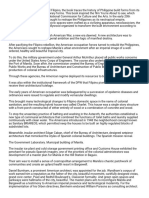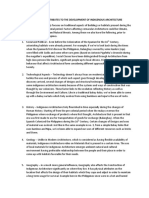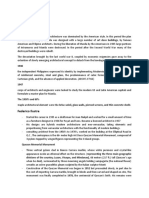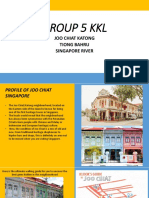Adaptive Reuse Examples in The Philippines PDF
Adaptive Reuse Examples in The Philippines PDF
Uploaded by
cbgwnkimCopyright:
Available Formats
Adaptive Reuse Examples in The Philippines PDF
Adaptive Reuse Examples in The Philippines PDF
Uploaded by
cbgwnkimOriginal Title
Copyright
Available Formats
Share this document
Did you find this document useful?
Is this content inappropriate?
Copyright:
Available Formats
Adaptive Reuse Examples in The Philippines PDF
Adaptive Reuse Examples in The Philippines PDF
Uploaded by
cbgwnkimCopyright:
Available Formats
Adaptive Reuse examples in the Philippines
Adaptive reuse is only one of the many methods of conservation. Where adaptive
reuse repurposes an old structure, restoration returns it back to its original splendor.
These structures not only speak of history, but they can also be profitable once adapted
into restaurants, hotels, museums, and more. This practice is called adaptive reuse—
keeping the physicality of the building intact while repurposing it for something else.
1919 Grand Café
Perhaps one of the most popular places for
adaptive reuse is Binondo, hailed as the
country’s—and the world’s—oldest Chinatown.
Every now and then, there are new constructions
on the rise in its narrow streets, but at its core,
Binondo is an old town with an old soul.
One such building in the Binondo area is 1919
Grand Café, a restaurant that looks like a set
from The Great Gatsby. Designed in the
Neoclassical Revival Style of its era, the building’s
construction began in 1919 and was opened in
1922 as the Hong Kong and Shanghai Banking
Corporation (HSBC) Building. Similar in fashion
to the British Colonial Era buildings in then-
British India, the building also housed the British
Consulate from 1946 to the 1960s. Eventually,
HSBC abandoned the building and the old
structure was forgotten in history books until it
was reopened in 2018 as 1919 Grand Café. From
the building’s original Corinthian columns and
intricate window grills to the British royal coat of
arms in the restaurant logo, a nod to history is
NEOCLASSICAL REVIVAL STYLE FACADE present in every corner of the café.
INTERIOR OF THE 1919 GRAND CAFE
Henry Hotel
THE FAÇADE OF THE HOTEL
Located inside the 2680 Compound along F.B. Harrison in Pasay City, The Henry Manila
is a 34-room boutique hotel spread across five Liberation-style houses which were lovingly
restored and repurposed for its guests. What used to be a compound of over five houses
in Pasay is currently known as The Henry Hotel Manila. Back in the '40s, however, it was
the home of a Filipino-Chinese business owner and his extended family. Its breathtaking
garden was landscaped by National Artist Ildefonso Santos and its 32 rooms all reflect the
lifestyle and interiors of decades past.
The houses’ simple architecture is spruced up by key design components, beginning with
the Scala grilles, inspired by the Art Deco style of the famous Scala Theater in Avenida
Rizal, designed by National Artist for Architecture Pablo Antonio. The floors are made of
baldoza tiles, which were in vogue during the period. Vibrant colors and varying patterns
in floral, vegetative, and geometric shapes decorate the tiles, further adding to the artistic
touch.
The same compound also houses the Avella Art Gallery and fashion designer Jojie
Lloren’s atelier.
REFERENCES:
• www.esquiremag.ph
• http://fnbreport.ph
Reaction Paper about the article entitled
‘Miagao Church’s naked coralline limestone, a mistake for authenticity’
Being an architecture student, during the time when I take the subject of History of
Architecture 4, I’ve been stunned by the beauty of Miagao Church. It is one of the baroque
churches that you can easily remember because of its unique and meaningful façade, it
exudes a native touch. Miagao church is one of the country’s architectural gems because of
its unique and impressive design. It stands as a living legacy of Filipino culture and our way
of life as one of the cultural heritages in the Philippines. The Miagao “Fortress” church is
one of the famous four great Baroque Spanish-era churches of the Philippines. The Miagao
Church also known as the Santo Tomás de Villanueva Parish Church is a Roman Catholic
church located in Miagao, Iloilo, Philippines.
The unique yellow ochre color of the church makes it more special; the Miagao
Church’s distinctive yellow-ochre color comes from the inclusion of coral that is ground into
dust and egg whites in the mixture for the adobes, according to my research. Its façade is a
combination of Spanish Baroque and Romanesque Early Medieval architectural styles, with
the addition of Chinese, Muslim, and local Filipino elements in the decoration of its façade,
which are the local motifs, such as the guava, papaya, and coconut trees that the local
laborers incorporated.
As an architecture student, it is very sad to know that the Miagao Church is now
deteriorating, and its condition had not improved. I believe that these kinds of churches
should be taken care of. I hope that the restorers will find a way to restore it properly and to
retain its beauty. Our local and national government should start maintaining our cultural
and historical patrimony before it is too late. The church’s survival is very important
especially to the future generations. It is part of the past and something that is relevant to
the future. The National Historical Commission of the Philippines, that removed the cement
plasterwork and cleaned the bas relief carvings on the façade should have replaced the
covering with a compatible plaster to protect it from deterioration and to other calamities.
Our country is tropical, with a hot and humid climate, accelerates the deterioration of the
stone. Although that some folks find those deterioration aesthetically appealing, I believe
that everyone should be informed especially the townsfolk near the area, that those changes
are not safe, and that weakens its load bearing capacity, especially that our country is located
in the Pacific Ring of Fire, and we experience frequent earthquakes, volcanic eruptions and
an average of twenty typhoons yearly.
The Miagao Church stands as a living legacy of the culture and way of life of the
people of Miagao centuries ago, anchored in a strong foundation of Christian faith. It is one
of the tourist destinations that our country can offer, Miagao Church is one of the country’s
architectural gems because of its unique and imposing designs, ornaments and motifs.
You might also like
- 2nd Generation of Filipino ArchitectsDocument14 pages2nd Generation of Filipino ArchitectsJAXXNo ratings yet
- Condominium Design StandardsDocument2 pagesCondominium Design StandardsBenjie Latriz100% (2)
- Cebu Map - Existing Landuse - MetroCebuDocument1 pageCebu Map - Existing Landuse - MetroCebuiamfrancoise0% (1)
- Philippine - Japan Active Carbon Corporation, PetitionerDocument2 pagesPhilippine - Japan Active Carbon Corporation, PetitionerAbe Puntual100% (2)
- Hypnotherapy For Dummies Cheat Sheet - For DummiesDocument4 pagesHypnotherapy For Dummies Cheat Sheet - For Dummiesnguyenhavn100% (1)
- Business Management and Application For Architecture 2Document51 pagesBusiness Management and Application For Architecture 2VictoriaNo ratings yet
- Behavioural Aspects of Housing-Report-Ppt-FinalDocument35 pagesBehavioural Aspects of Housing-Report-Ppt-FinalLaNZ NesirioNo ratings yet
- Adaptive Reuse Examples in The PhilippinesDocument3 pagesAdaptive Reuse Examples in The PhilippinescbgwnkimNo ratings yet
- Arkitekturang Filipino 4 - Imperial Imaginings - American A...Document2 pagesArkitekturang Filipino 4 - Imperial Imaginings - American A...ISABELLE MAXINE MANTO67% (3)
- Burnham Park Master Development PlanDocument3 pagesBurnham Park Master Development Planalex050508100% (1)
- FILIPINO ARCHITECTS 3 - Fernando OcampoDocument2 pagesFILIPINO ARCHITECTS 3 - Fernando OcampoEmmanuel Inocencio100% (1)
- Factors That Contributes To The Development of Indigenous ArchitectureDocument2 pagesFactors That Contributes To The Development of Indigenous ArchitectureVlademir PancoNo ratings yet
- Post War ArchitectureDocument12 pagesPost War ArchitectureANNA PATRICIA REYNOSONo ratings yet
- Arkitekturang FilipinoDocument3 pagesArkitekturang FilipinoPau LlenaNo ratings yet
- 1st Generation ArchitectsDocument9 pages1st Generation ArchitectsBenjie LatrizNo ratings yet
- Development ControlsDocument2 pagesDevelopment ControlsJohn LouieNo ratings yet
- HOA 4 Module 2Document5 pagesHOA 4 Module 2Alex100% (1)
- Adaptive Reuse of El Hogar Building UnfinishedDocument16 pagesAdaptive Reuse of El Hogar Building UnfinishedJennylyn MasNo ratings yet
- Between The Earth and SkyDocument3 pagesBetween The Earth and SkyLyra EspirituNo ratings yet
- RSW Aesthetic and Physical Considerations in Site PlanningDocument6 pagesRSW Aesthetic and Physical Considerations in Site PlanningJuan Carlos Untalan Del PradoNo ratings yet
- The Political Reality of Globalization and The Open Practice of Architecture in The Philippines - 2 PDFDocument101 pagesThe Political Reality of Globalization and The Open Practice of Architecture in The Philippines - 2 PDFGrondour Seven100% (1)
- Sta. Rosa Property Information As Per ClupDocument4 pagesSta. Rosa Property Information As Per ClupRogerMelgarBarataNo ratings yet
- F4.2 Mabalacat ZO 2018Document67 pagesF4.2 Mabalacat ZO 2018Jeysii Padua100% (1)
- Philosophy and Logic LessonsDocument1 pagePhilosophy and Logic LessonscbgwnkimNo ratings yet
- VBNGNre e BankingDocument3 pagesVBNGNre e BankingbkaaljdaelvNo ratings yet
- Contemporary Architecture and The New MilleniumDocument83 pagesContemporary Architecture and The New Milleniumzeu chNo ratings yet
- Lec 9 Beginning of The Architecture Practice in The PhilippinesDocument3 pagesLec 9 Beginning of The Architecture Practice in The PhilippinesPinkyMaeVillarosaQuiñonesNo ratings yet
- Juan Marcos Arellano y de GuzmánDocument11 pagesJuan Marcos Arellano y de GuzmánCedie Aviles Serafica100% (2)
- Philosophies & Famous Works of Filipino Arch'Ts:: Leandro LocsinDocument5 pagesPhilosophies & Famous Works of Filipino Arch'Ts:: Leandro LocsinLouie Jay PoligratesNo ratings yet
- The Importance of The 5-External Environment in The Professional Practice of Architecture.Document2 pagesThe Importance of The 5-External Environment in The Professional Practice of Architecture.lester aceNo ratings yet
- Behavioral Aspect of HousingDocument3 pagesBehavioral Aspect of Housingmartindinglasan100% (1)
- AR 2231: History of Architecture 4 - Midterm ReviewerDocument31 pagesAR 2231: History of Architecture 4 - Midterm ReviewerreseeNo ratings yet
- Alfredo LuzDocument15 pagesAlfredo LuzKIM ADRIAN MAGTIBAYNo ratings yet
- Works of Pioneer Architects PDFDocument23 pagesWorks of Pioneer Architects PDFKimNo ratings yet
- Specialized Allied ServicesDocument30 pagesSpecialized Allied ServicesJesi ViloriaNo ratings yet
- HOA 4 GROUP 2 HANDOUTS Spanish Colonial Architecture Part 2.edited 1Document13 pagesHOA 4 GROUP 2 HANDOUTS Spanish Colonial Architecture Part 2.edited 1Moa Alyanna Trinidad0% (1)
- GROUP NO1 - Supplemental Services of The ArchitectDocument52 pagesGROUP NO1 - Supplemental Services of The ArchitectRitzel Gaffud0% (1)
- Philippine Perspective On HousingDocument3 pagesPhilippine Perspective On Housingtom macasojot100% (1)
- Propac Reaction Paper On Architects Laws PDFDocument3 pagesPropac Reaction Paper On Architects Laws PDFJetrho LimiacNo ratings yet
- Ecological Considerations of Site DevelopmentDocument15 pagesEcological Considerations of Site DevelopmentKhalid Ali Saif Al-ShamsiNo ratings yet
- PIA History - Filipino ArchitectsDocument16 pagesPIA History - Filipino ArchitectsMichael RojasNo ratings yet
- Pearl Farm ResortDocument3 pagesPearl Farm ResortTroy Kenneth AlamaresNo ratings yet
- Carlos Santos ViolaDocument16 pagesCarlos Santos ViolaJinky Ecija0% (1)
- Architect'S Schedule of Minimum Basic FeeDocument3 pagesArchitect'S Schedule of Minimum Basic FeeMarlon NiduazaNo ratings yet
- 04 HOA Philippine Arch American ColonialDocument10 pages04 HOA Philippine Arch American ColonialCistron Exon100% (1)
- SPP 205 Post Construction ServiceDocument2 pagesSPP 205 Post Construction ServiceArch. Jan EchiverriNo ratings yet
- Social and Psychological Considerations of Site PlanningDocument4 pagesSocial and Psychological Considerations of Site PlanningUnette C. JulianNo ratings yet
- MUSLIM SPACE and The Philippine Islamic ArchitectureDocument71 pagesMUSLIM SPACE and The Philippine Islamic ArchitectureMichelle Miranda0% (2)
- UAP DOC 203 - Specialized Allied ServicesDocument11 pagesUAP DOC 203 - Specialized Allied Servicesjbonvier100% (1)
- Vernacular Architecture of Philippines': Submitted To: Ar - Kajal HandaDocument53 pagesVernacular Architecture of Philippines': Submitted To: Ar - Kajal HandaMj OhNo ratings yet
- HOA 1 Lecture Module 1Document21 pagesHOA 1 Lecture Module 1Guiller Jr OdonoNo ratings yet
- Topic 4 Orientation & Identity in Community ArchitectureDocument37 pagesTopic 4 Orientation & Identity in Community ArchitectureAliza Marie PlacinoNo ratings yet
- THEORY OF ARCHITECTURE I - Translation of Mind Museum in Taguig City, Philippines PDFDocument12 pagesTHEORY OF ARCHITECTURE I - Translation of Mind Museum in Taguig City, Philippines PDFDon Lapus100% (1)
- Philippine Vernacular ArchitectureDocument24 pagesPhilippine Vernacular ArchitectureArianne Joy Quiba Dullas100% (1)
- Reflection PaperDocument1 pageReflection PaperDanica Lyne Dela Cruz100% (1)
- RSW 2 Design Guidelines For Government Building ComplexDocument22 pagesRSW 2 Design Guidelines For Government Building ComplexJohn Kenneth Carcido Maneclang100% (1)
- Topics: 5.3 Sensuous Quality 5.4 Vocabulary of Space 5.4.1 Sensuous FormDocument34 pagesTopics: 5.3 Sensuous Quality 5.4 Vocabulary of Space 5.4.1 Sensuous Formjarih50% (2)
- Architectural Design Philosophy List Document FileDocument51 pagesArchitectural Design Philosophy List Document FileFinn EncinaresNo ratings yet
- Ecological Consideration of The Site: Planning 01Document26 pagesEcological Consideration of The Site: Planning 01Ralph Vincent Valdez Tamang0% (1)
- Juan Marcos de Guzman Arellano PDFDocument2 pagesJuan Marcos de Guzman Arellano PDFSam Dichoso100% (2)
- Microclimatic ConsiderationsDocument9 pagesMicroclimatic ConsiderationsDenice Nicole CatapiaNo ratings yet
- Uap 204-208Document26 pagesUap 204-208smmNo ratings yet
- Adaptive Reuse Examples in The PhilippinesDocument3 pagesAdaptive Reuse Examples in The PhilippinescbgwnkimNo ratings yet
- Group 5 KKL: Joo Chiat Katong Tiong Bahru Singapore RiverDocument14 pagesGroup 5 KKL: Joo Chiat Katong Tiong Bahru Singapore RivernindyaNo ratings yet
- MasterFormat Specification DivisionsDocument2 pagesMasterFormat Specification DivisionscbgwnkimNo ratings yet
- What We Can Learn From The Exquisite History and Ornate Aesthetic of Gothic ArchitectureDocument2 pagesWhat We Can Learn From The Exquisite History and Ornate Aesthetic of Gothic ArchitecturecbgwnkimNo ratings yet
- Philosophy and Logic NotesDocument2 pagesPhilosophy and Logic NotescbgwnkimNo ratings yet
- Proprac NotesDocument2 pagesProprac NotescbgwnkimNo ratings yet
- Plaza Roma Manila CathedralDocument26 pagesPlaza Roma Manila CathedralcbgwnkimNo ratings yet
- Adaptive Reuse Examples in The PhilippinesDocument3 pagesAdaptive Reuse Examples in The PhilippinescbgwnkimNo ratings yet
- Macbeth and DR Jekyll Practice Questions and WalkthroughsDocument5 pagesMacbeth and DR Jekyll Practice Questions and WalkthroughsVedant PapnejaNo ratings yet
- Attached and Marked As Annex "A" Is The USB Containing The Video Attached and Marked As Annex "B-Series" Are The Screenshots From The VideoDocument2 pagesAttached and Marked As Annex "A" Is The USB Containing The Video Attached and Marked As Annex "B-Series" Are The Screenshots From The Videomichelle BarrancoNo ratings yet
- Practice Test 12-5 Part One: Listening: Page 1 of 6Document8 pagesPractice Test 12-5 Part One: Listening: Page 1 of 6Ánh PhanNo ratings yet
- The Phases of Menstrual CycleDocument5 pagesThe Phases of Menstrual CycleKristine AlejandroNo ratings yet
- FennelDocument2 pagesFennelAlesam44bNo ratings yet
- Switching Ace-Inhibitors: Change To Change From Enalapril Quinapril RamiprilDocument2 pagesSwitching Ace-Inhibitors: Change To Change From Enalapril Quinapril RamiprilGlory Claudia KarundengNo ratings yet
- People vs. GenosaDocument2 pagesPeople vs. GenosaTabitha Peña0% (1)
- Áthinkinsforherself!: The Personal Wa$ Invented by Long-Haired and Steven The Lesser - and Complete The ElectronicDocument5 pagesÁthinkinsforherself!: The Personal Wa$ Invented by Long-Haired and Steven The Lesser - and Complete The ElectronicYosu Bravo UribeNo ratings yet
- Article Exercises 1 Full Score 1Document10 pagesArticle Exercises 1 Full Score 1cdmbNo ratings yet
- Regional AspirationDocument66 pagesRegional Aspirationsungsam.211205No ratings yet
- Edward Van Halen - Eddify Me (Guitar Player Lesson)Document6 pagesEdward Van Halen - Eddify Me (Guitar Player Lesson)james bond100% (2)
- Access Assessment and Continuity of CareDocument35 pagesAccess Assessment and Continuity of Careshubham solankiNo ratings yet
- Gender, Religion and Caste-Question-717199Document8 pagesGender, Religion and Caste-Question-717199Shivangi MauryaNo ratings yet
- Holiday List Session 2024-25Document1 pageHoliday List Session 2024-25dudhn476No ratings yet
- D&D ChartsDocument2 pagesD&D Chartscara yacovoneNo ratings yet
- Indian Institute of Management Ahmedabad: Organizational DynamicsDocument10 pagesIndian Institute of Management Ahmedabad: Organizational DynamicsShashwat SiddhantNo ratings yet
- Impact of Yellow Journalism On SocietyDocument2 pagesImpact of Yellow Journalism On SocietyFarhan BhuttoNo ratings yet
- F 5 C 2Document14 pagesF 5 C 2jalrizal7No ratings yet
- RICOH FX 16 Service ManualDocument160 pagesRICOH FX 16 Service ManualNenad SikimićNo ratings yet
- Brand StrategyDocument31 pagesBrand StrategyRoy ProjectNo ratings yet
- Chem1031 Study Notes For UNSWDocument37 pagesChem1031 Study Notes For UNSWOliverNo ratings yet
- PublishedDocument31 pagesPublishedScribd Government DocsNo ratings yet
- Materials Inventory Management To Reduce Holding Cost and Backlog (System Dynamics Approach: A Case Study)Document14 pagesMaterials Inventory Management To Reduce Holding Cost and Backlog (System Dynamics Approach: A Case Study)Abdalla Nagimeldin MohamedNo ratings yet
- Bataan National High School Senior High School: Grade 11 - Personal Development ClassDocument57 pagesBataan National High School Senior High School: Grade 11 - Personal Development ClassAnna Kathleen LimNo ratings yet
- Tremester Ii English Test Grade 12 Name - Stream - No.Document2 pagesTremester Ii English Test Grade 12 Name - Stream - No.lugbishNo ratings yet
- Far He en Begum ResumeDocument1 pageFar He en Begum Resumefarhibidayah24No ratings yet
- Physics 1Document24 pagesPhysics 1ZainabNo ratings yet































































































